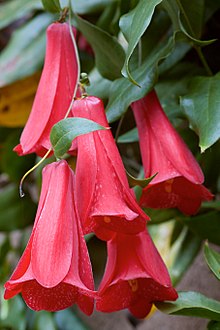Lapageria

Lapageria is a genus of flowering plants with only one known species, Lapageria rosea, commonly known as Chilean bellflower or copihue (co-pee-way < Mapudungun kopiwe).[2] Lapageria rosea is the national flower of Chile. It grows in forests in the southern part of Chile, being part of the Valdivian temperate rain forests flora. In the past its fruit was sold in markets, but the plant has now become rare through over-collection and forest clearance. The roots were once collected and used as a substitute for sarsaparilla. In 1977 the plant was given legal protection in Chile. Lapageria is named for Marie Joséphine Rose Tascher de la Pagerie (1763-1814), also known as Napoleon's Empress Josephine, who was a keen collector of plants for her garden at Château de Malmaison.[3] Rosea means 'flushed rose' or 'flushed pink'.[3] The name of the fruit in Mapudungun is actually kopiw (derived from kopün, "to be upside down"), which is the etymon of Spanish copihue; the Mapuche call the plant kolkopiw (colcopihue in Spanish, which may also refer to the whole plant). The flower is called kodkülla in the indigenous language.[2] Botany Lapageria rosea is related to Philesia magellanica (syn. P. buxifolia), another plant from the Valdivian flora, having similar flowers, but shrubby rather than climbing.[citation needed] ×Philageria veitchii is a hybrid between L. rosea and P. magellanica. It is more similar in appearance to the former. Growth habit Lapageria rosea is an evergreen climbing plant reaching over 10 m high among shrubs and trees. The leaves are arranged alternately and are evergreen, leathery, lanceolate and feature three to seven prominent parallel veins. The vines twine counterclockwise in the Southern hemisphere and clockwise when grown in the Northern hemisphere (likely due to the Sun). The flowers have six thick, waxy tepals which are red, spotted with white. They are most frequently produced in late summer and fall, although they may be produced at other times. The fruit is an elongated berry with a tough skin containing numerous small seeds about the size of a tomato seed, which are covered in an edible fleshy aril. In the wild the plant is pollinated by hummingbirds. Pollen is distributed by birds, insects and other animals. Insect pollinators include: Bombus dahlbomii (native species to southern South America) and Bombus terrestris and Bombus ruderatus (both of which are not native to southern South America, and, instead, invasive).[4][5]
